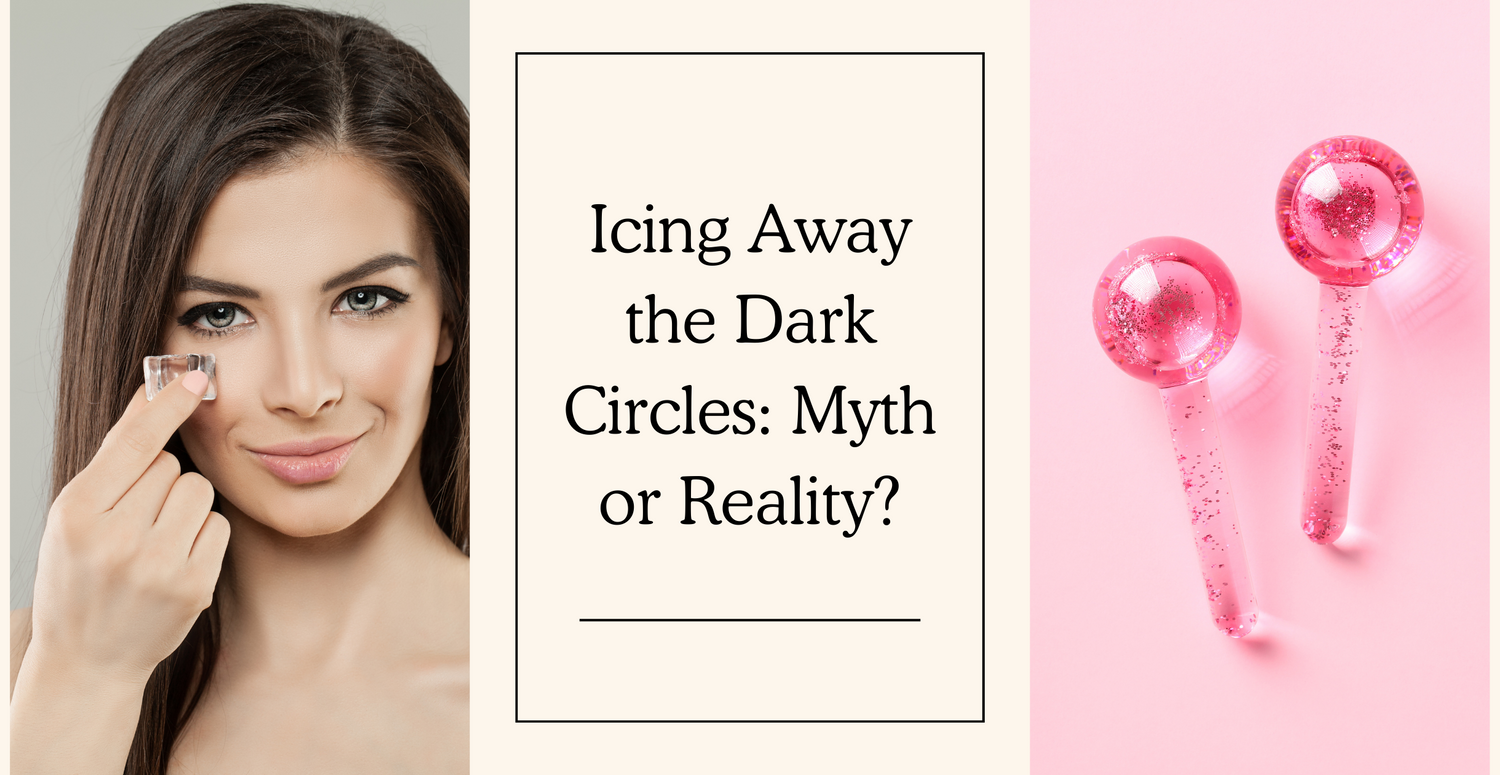The use of ice or cold compresses to treat dark circles under the eyes is a frequent practise that is thought to reduce puffiness and constrict blood vessels, potentially reducing the appearance of dark circles. However, its efficiency varies from person to person, and it may not be enough to fully eradicate dark circles.
Uncovering the Effectiveness of Ice on Dark Circles
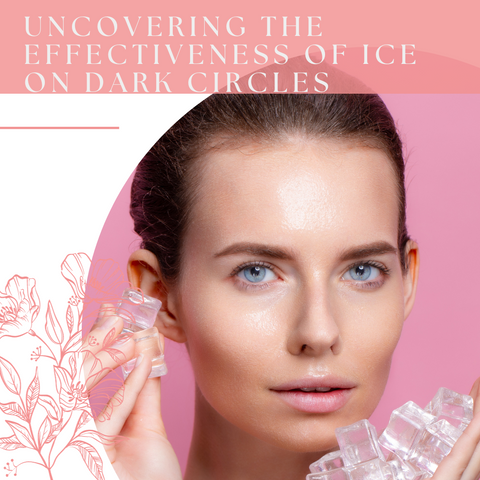
Using ice or cold compresses to cure dark circles is a popular home remedy that is said to reduce puffiness and maybe diminish the appearance of dark circles beneath the eyes. However, the effectiveness of applying ice to dark circles differs by individual and may only provide limited assistance in resolving some areas of this issue. While utilising ice or cold compresses to reduce puffiness around the eyes may provide immediate comfort, their usefulness in addressing dark circles caused by pigmentation or other underlying reasons may be limited. For a more complete approach, it's best to experiment with different skincare techniques and speak with a dermatologist for personalised advice and treatments that target particular causes of dark circles.
How Does Ice Impact Under-Eye Circulation?
Due to the effects of freezing temperatures on blood vessels and tissues, applying ice or cold compresses to the under-eye area might alter circulation and blood flow. The following are the effects of ice on under-eye circulation:
Vasoconstriction:
-
Constriction of Blood Vessels: Cold temperatures cause blood vessels to constrict or narrow. When ice is applied to the skin, particularly the sensitive under-eye area, the blood vessels contract, reducing their diameter.
-
Reduced Blood Flow: Constrictions in the blood vessels temporarily reduce blood flow to the area. This decrease in blood flow can result in less swelling, puffiness, and inflammation around the eyes, especially after a night of poor sleep or due to factors such as allergies.
Effects on Circulation:
-
Temporary Circulatory Changes: Applying ice to the under-eye area can temporarily slow or restrict blood flow. This temporary decrease in circulation may help to reduce puffiness and dark circles caused by increased blood pooling or fluid retention.
-
Limited Duration of Effect: Applying ice causes blood vessels to constrict, which has a temporary effect on circulation. The blood vessels progressively widen and return to normal after the cold treatment is stopped, resulting in the restoration of regular blood flow.
While ice can temporarily improve under-eye circulation by constricting blood vessels and reducing puffiness, it may be ineffective in addressing persistent dark circles. Long-term solutions should include comprehensive skincare routines, lifestyle changes, or professional advice to address specific causes of dark circles.
Comparing Ice to Other Natural Remedies
Aside from ice, different natural therapies are commonly considered when addressing under-eye issues such as puffiness and dark circles. Here's a comparison of ice to various natural therapies and their impact on under-eye concerns:
-
Cucumber Slices: Effect: Cucumber slices contain antioxidants and mild astringent properties that, due to their cooling effect, may temporarily reduce puffiness. They also moisturise the skin. How They Work: Cucumbers, like ice, provide a cooling sensation that may constrict blood vessels and reduce inflammation around the eyes.
-
Tea Bags (Chamomile or Green Tea): Effect: Tea bags, particularly chamomile or green tea, contain antioxidants and anti-inflammatory properties that may help reduce puffiness and soothe the skin. How They Work: The tannins and antioxidants in tea bags may help to tighten blood vessels and tighten skin, which will lessen puffiness and swelling around the eyes.
-
Potatoes: Effect: Packed with vitamins, enzymes, and natural bleaching agents, potatoes may help lighten dark circles and minimise puffiness. How They Work: Potato enzymes and natural bleaching capabilities may help decrease dark circles, while the cooling impact may reduce puffiness.
-
Aloe Vera Gel: Effect: With its calming, moisturising, and anti-inflammatory qualities, aloe vera gel may help relieve puffiness and soothe the sensitive skin around the eyes. How It Works: Aloe vera's moisturising qualities may calm the skin and its anti-inflammatory qualities may help reduce swelling.
-
Effect of Witch Hazel: Effect: Due to its astringent qualities, witch hazel may help tighten skin and lessen inflammation. How It Works: Astringent properties of witch hazel can temporarily reduce puffiness and tighten the skin around the eyes.
Safe Application of Ice for Eye Care
Using ice for eye care, particularly to relieve puffiness or discomfort around the eyes, is safe if the following rules are followed:
Application:
-
Place Over Closed Eyelids: Gently place the wrapped ice or cold compress over the closed eyelids, making sure it covers any puffiness or discomfort.
-
Avoid Excessive Pressure: Do not apply excessive force or compress the ice against the eyes. To prevent pain or harm, always use a light touch.
-
Take Breaks: If applying ice for an extended period of time, give your skin a chance to warm up in between applications. This shields the skin from prolonged exposure to cold.
Safety Precautions:
-
Preserve Sensitive Skin: To avoid direct contact between the ice or compress and the skin, place a thin cloth or paper towel between them. This shields the delicate skin surrounding the eyes from irritation or possible frostbite.
-
Track Adverse Reactions on the Skin: Keep an eye out for any uncomfortable or excessively red skin reactions. Discontinue if you experience any unusual sensations.
-
Avoid Applying Straight to Open Injuries: To avoid further irritation or complications, avoid applying ice directly to open wounds or injuries around the eyes.
The Science Behind Cold Therapy for Eyes
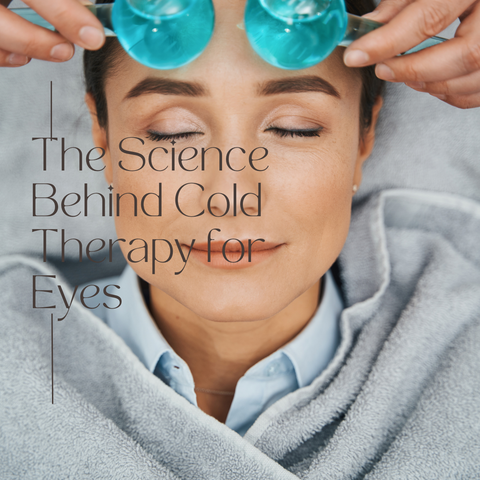
Cold therapy, which includes using ice or cold compresses on the eyes, entails administering freezing temperatures to the skin. The science underlying cold therapy for eyes is primarily concerned with the body's physiological responses to cold temperatures. When used properly and for the appropriate durations, cold therapy for the eyes can temporarily relieve puffiness, irritation, or edoema. It is important to remember, however, that its effects are transitory and may not address underlying causes of eye problems. Professional supervision and comprehensive eye care approaches may be required for persistent or chronic eye disorders.
Benefits of Cold Compresses for Puffy Eyes
When used to treat swollen eyes, cold compresses have various benefits, including pain relief and a reduction in the appearance of swelling:
Soothing and Comfort:
-
Soothing Effect: The cooling sensation of cold compresses can provide immediate relief, soothing the skin and reducing feelings of heat, discomfort, or irritation around the eyes.
-
Numbing Sensation: Cold temperatures can temporarily numb nerve endings, providing a mild analgesic effect that may alleviate minor discomfort or irritation.
Temporary Relief:
-
Quick Fix for Temporary Puffiness: Cold compresses are frequently a simple, fast way to temporarily improve the appearance of puffiness or swelling around the eyes.
-
Refreshed Appearance: Using cold compresses can minimise the appearance of tired or swollen eyes and reduce puffiness, giving the skin a refreshed appearance.
Anti-Inflammatory Effects:
-
Reduced Inflammation: The anti-inflammatory qualities of cold therapy can aid in reducing inflammation in the tissues surrounding the eyes, which helps to lessen puffiness.
-
Relief from Sinus Problems or Allergies: By narrowing blood vessels and lowering swelling, cold compresses help reduce puffiness brought on by sinus congestion or allergies.
While cold compresses provide immediate relief and minimise the appearance of swollen eyes, their benefits are transient and may fail to address the underlying reasons of recurrent eye problems. Consultation with a healthcare specialist is recommended for correct evaluation and treatment of persistent or severe puffiness, underlying medical issues, or concerns regarding eye health.
Limitations and Precautions of Using Ice
While utilising ice or cold compresses can give a variety of benefits, it's important to understand their limitations and take the appropriate care to avoid any negative effects:
Limitations:
-
Temporary Relief: Applying cold compresses or ice is only going to have a temporary effect. The benefits of the cold treatment are transient, and the skin returns to normal once the treatment is stopped.
-
Treating Underlying Causes: Although cold compresses may provide short-term relief from symptoms like puffiness or swelling, they may not treat the underlying causes of long-term eye problems, such as persistent dark circles or particular medical conditions.
-
Limited Effect on Pigmentation: Cold compresses can help minimise swelling and puffiness, but they may not have a major effect on dark circles or other discoloration problems related to pigmentation.
Precautions:
-
Protect the Skin: Always place a cloth or a barrier between the ice or cold compress and the skin to avoid direct contact and potential frostbite or skin irritation.
-
Limit Duration: Apply ice or cold compresses for brief periods of time (about 10-15 minutes at a time). Prolonged exposure to cold temperatures can cause skin damage and have negative consequences.
-
Monitor Skin Reactions: Watch for any adverse reactions such as excessive redness, numbness, or discomfort. Discontinue if you experience any unusual sensations.
-
Avoid Direct Contact with Open Injuries: To avoid aggravating or complicating open wounds, injuries, or sensitive skin areas, avoid applying ice directly to them.
-
Take Sensitivities into Account: Those who have rosacea or other sensitive skin conditions should exercise caution when utilising cold therapy as it may aggravate their sensitivity or cause flare-ups.
-
Consult a Professional: If you have underlying eye conditions or concerns, or if you have persistent puffiness, you should seek the advice of an eye care professional or dermatologist.
While using ice or cold compresses to reduce eye puffiness is a simple and accessible option, it is critical to use them with caution, limit exposure duration, and seek professional assistance if you have underlying eye disorders or recurring concerns.
Integrating Ice Therapy into Your Skincare Routine
Incorporating ice treatment into your skincare routine can bring numerous benefits, including reduced puffiness, skin calming, and skin revitalization. Here's how to efficiently incorporate ice therapy:
-
Cleanse the Skin: Begin by cleaning your face with a gentle cleanser appropriate for your skin type. This eliminates debris, oils, and makeup off the skin, preparing it for the ice treatment.
-
Prepare the Ice: Wrap ice cubes in a clean handkerchief or apply a cold compress to the affected area. To avoid frostbite or skin irritation, avoid direct contact with ice.
-
Focus on Problem Areas: Wrap the ice or cold compress and apply it to regions prone to puffiness or inflammation, such as the under-eye area, cheeks, or enlarged pores. Use circular, soft motions.
-
Duration and Technique: Gently glide the ice in upward and outward motions for about 1-2 minutes per area. Be mindful of not applying excessive pressure or leaving the ice on the skin for too long.
-
Take Breaks: If you are using ice for an extended period of time, take breaks in between applications to enable the skin to warm up. This keeps the skin from being overly chilly.
-
Follow with Skincare Products: Apply your usual skincare products, such as serums, moisturisers, or eye creams, after the ice treatment. The cold skin can improve product absorption and hence increase their effectiveness.
-
Hydrate and Protect: Finish your routine with a hydrating and protective step, such as applying a broad-spectrum sunscreen during the day or a nourishing night cream before bedtime.
Beyond Ice: Comprehensive Care for Dark Circles
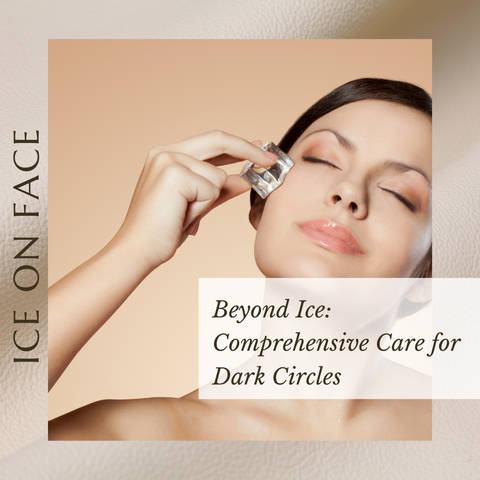
Genetics, pigmentation, thinning skin, lack of sleep, allergies, or lifestyle behaviours can all contribute to dark circles around the eyes. While ice therapy and cold compresses can provide temporary relief for puffiness, comprehensive care for dark circles entails a multifaceted approach that includes proper skincare, targeted ingredients, adequate sleep and lifestyle changes, home remedies, professional treatments, and consultation with a dermatologist. Consult a dermatologist or skincare expert if dark circles persist after home treatments and lifestyle modifications. They can assess your individual concerns and offer personalised treatments or procedures that are tailored to your specific requirements. Over time, a complete approach that combines skincare, lifestyle changes, targeted products, and professional advice can effectively remove dark circles and improve the appearance of the under-eye area.
Effective Hydration for the Under-Eye Area
Effectively hydrating the under-eye area is critical for skin health and decreasing the appearance of fine lines, puffiness, and dark circles. Hydrating elements in skincare, the right application techniques, cooling and soothing treatments, lifestyle improvements for hydration, guarding and prevention, and a healthy diet and sleep are some useful hydration approaches for the delicate under-eye region. Maintaining consistency in these practises can aid in maintaining appropriate hydration levels and improving the appearance of the under-eye area.
Lifestyle Changes to Combat Dark Circles
Combating dark circles frequently entails lifestyle changes that might help address the underlying reasons or exacerbating variables that contribute to their appearance. Here are some lifestyle adjustments that may aid in the reduction of dark circles:
-
Ensure Adequate Sleep: Aim for 7-9 hours of quality sleep per night. Sleep deprivation can cause blood vessel dilation, making dark circles more visible.
-
Hydrate well: Drink plenty of water throughout the day to stay hydrated. Proper hydration helps to maintain skin elasticity and reduces the appearance of dark circles.
-
Balanced Diet: Eat a well-rounded diet rich in fruits, vegetables, lean proteins, and foods high in antioxidants and vitamins. Nutrient-dense foods promote skin health and reduce the appearance of dark circles.
-
Manage Allergies: Address any allergies that may be causing under-eye discoloration. Consult an allergist or a healthcare professional for appropriate allergy treatment or management.
-
Limit Alcohol and Caffeine: Limit alcohol and caffeine consumption because they can dehydrate the body and cause puffiness and dark circles.
-
Manage Stress: Engage in stress-relieving activities such as meditation, yoga, or deep breathing exercises. Chronic stress can interfere with sleep and contribute to dark circles.
-
Eye Protection: Wear sunglasses with UV protection to protect the delicate under-eye area from harmful sun exposure, which can worsen pigmentation.
-
Prevent Eye Strain: To lessen eye strain, take breaks from screens, change the brightness of your screen, and follow the 20-20-20 rule, which calls for 20 seconds of focused, 20-foot starting every 20 minutes.
-
Good Skincare: Apply a mild cleanser and refrain from pulling or scrubbing the eye area. To avoid causing irritation, take caution when taking off makeup.
-
Exercise on a Regular Basis: Increasing blood circulation through regular physical activity can help maintain skin health and lessen the appearance of dark circles under the eyes.
-
Proper Sleep Position: Raise your head slightly while you sleep to avoid accumulating fluid around your eyes, which will minimise puffiness and make dark circles less noticeable in the morning.
-
Seek Professional Advice: Speak with a dermatologist or other healthcare provider if dark circles do not go away despite lifestyle modifications. They can offer tailored advice or therapies for particular underlying issues.
By addressing contributing factors and promoting overall skin health, adopting these lifestyle changes may help reduce the appearance of dark circles over time. Maintaining these routines consistently will help you see possible improvements in under-eye issues.
Professional Treatments vs. Home Remedies
The degree of the issue, underlying causes, individual preferences, and financial limitations all play a role in the decision between professional and DIY treatments for dark circles under the eyes. Here is a comparison of professional treatments against home remedies:
Home Remedies:
Advantages:
-
Accessibility and Affordability: Using natural ingredients like cucumber, tea bags, or cold compresses, home remedies are frequently easily incorporated into routines, easily accessible, and reasonably priced.
-
Mild and Natural: Home cures for minor issues like puffiness or mild discoloration are usually mild on the skin and may offer momentary relief.
Limitations:
-
Limited Effectiveness: The effectiveness of home remedies for more severe or persistent dark circles brought on by pigmentation, heredity, or other underlying problems may be limited.
-
Temporary Results: Home remedies typically have short-term effects and may not result in noticeable long-term improvements.
Professional Treatments:
Advantages:
-
Targeted and Effective: Expert procedures like chemical peels, laser therapy, and dermal fillers are made especially to address the different root causes of dark circles, providing longer-lasting and more efficient results.
-
Customised Approach: Skincare experts or dermatologists can customise treatments to address your unique issues and offer unique answers for various kinds of dark circles.
Limitations:
-
Cost and Accessibility: Some people find professional treatments to be less accessible due to their higher cost and potential need for multiple sessions.
-
Potential Risks: Side effects, allergic reactions, and skin irritation are possible risks associated with some professional treatments. Before having any surgery, it is important to speak with a specialist and be aware of any possible risks.
Elevating Your Eye Care Regimen
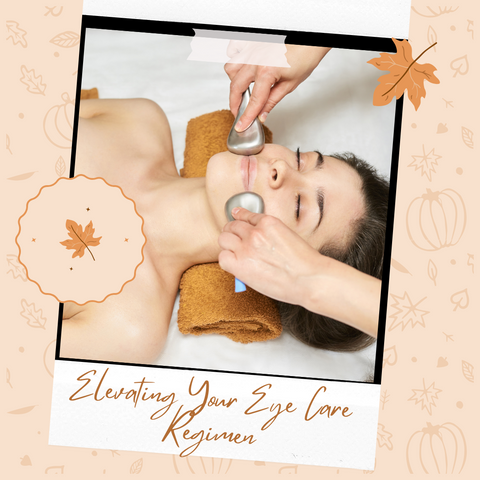
Elevating your eye care regimen entails implementing effective tactics and products designed specifically to address under-eye issues. Here are some tips to improve your eye care routine:
-
Gentle Cleansing: Use a gentle, fragrance-free cleanser to remove makeup, grime, and pollutants without irritating the sensitive eye area.
-
Targeted Eye Creams or Serums: To maintain moisture levels and fill the face, look for eye creams or serums that contain moisturising components like hyaluronic acid or glycerin. To fight against free radicals and brighten the under-eye area, look for products containing antioxidants (such as vitamin C or green tea extract).
-
Application Techniques: Apply eye creams or serums using your ring finger, tapping lightly or using gentle circular motions to encourage absorption without tugging at the skin. Refrigerate eye creams or serums for a cooling effect that can help reduce puffiness and soothe the skin.
-
Sun Protection: The under-eye area should be protected from damaging UV rays by using sunscreen or wearing sunglasses with UV protection to avoid pigmentation and premature ageing.
-
Treat Specific Concerns: To address pigmentation or lessen the appearance of dark circles, look for products that contain chemicals like retinoids, peptides, or vitamin K. Caffeine and cooling components like cucumber in eye treatments might help reduce puffiness by restricting blood vessels and calming the skin.
-
Hydrating Masks or Patches: Once or twice a week, apply hydrating eye masks or patches to deliver a strong hydration boost and address specific symptoms such as puffiness or weary eyes.
-
Lifestyle Factors: Make sure you receive enough quality sleep to avoid weary eyes and puffiness. To maintain skin health and decrease under-eye issues, eat a well-balanced diet high in antioxidants, vitamins, and omega-3 fatty acids.
-
Professional Treatments: If you have recurrent issues or want more targeted results, see a dermatologist for specialised treatments such as laser therapy, chemical peels, or injectable fillers.
-
Consistency and Patience: Consistency is essential. Include these measures in your everyday routine and give it some time. Skincare results often take time to become visible.
You can improve the quality of your eye care routine and effectively treat under-eye issues while preserving the health and appearance of the delicate skin around your eyes by implementing these steps and using products that are specific to your needs. Always remember to patch-test new products and, if necessary, seek individualised advice from a skincare expert.
Innovative Skincare Products for Eye Rejuvenation
There are various revolutionary skincare products available that are specifically developed for eye rejuvenation. These medicines use innovative formulations and cutting-edge components to address a variety of issues concerning the delicate under-eye area. Here are some examples of cutting-edge skincare products:
-
Retinol Eye Creams: Benefits: Retinol-based eye creams provide anti-aging benefits by stimulating collagen production, reducing fine lines, and improving skin texture. Innovation: Some products combine retinol with novel delivery systems to improve penetration and reduce irritation.
-
Eye Serums with Peptides: Benefits: Peptides help tighten skin, minimise fine lines, and lessen puffiness and dark circles. Innovation: Advanced peptide complexes developed to target specific concerns including as elasticity and moisture are included in innovative formulations.
-
Hyaluronic Acid Eye Gels: Benefits: Hyaluronic acid gels hydrate the under-eye area profoundly, plumping the skin and diminishing the appearance of fine wrinkles and dryness. Innovation: Some products contain microencapsulated hyaluronic acid for targeted, long-lasting hydration.
-
Vitamin C Eye Creams: Benefits: Vitamin C brightens the skin, evens out pigmentation, and aids in the reduction of dark circles. Innovation: For improved stability and efficacy, innovative formulations combine antioxidants with stabilised vitamin C.
-
Caffeine-Infused Eye Products: Benefits: Caffeine helps reduce puffiness and inflammation by constricting blood vessels. Innovation: Products may feature advanced delivery systems that optimize caffeine absorption for better efficacy.
-
Advanced Eye Masks or Patches: Benefits: Innovative hydrogel or bio-cellulose eye masks/patches hydrate deeply, reduce puffiness, and soothe tired eyes. Innovation: Some masks incorporate innovative ingredients like botanical extracts or stem cell technology for enhanced rejuvenation.
-
Adaptive Eye Creams: Benefits: Adaptive eye creams respond to the needs of the skin, offering targeted hydration, firming, or brightness based on individual needs. Innovation: Products feature adaptive complexes or responsive components that cater to various skin disorders.
-
Microcurrent Eye Devices: Benefits: Innovative handheld devices use microcurrent technology to tone and firm the delicate eye area, reducing puffiness and enhancing product absorption. Innovation: Some devices come with varying intensity levels and innovative applicator tips for precise and comfortable usage.
Consider your specific concerns, skin type, and sensitivities while using revolutionary skincare products for eye rejuvenation. Patch-test new products, follow product directions, and seek personalised advice from a dermatologist or skincare professional.
Dietary Adjustments for Healthier Skin
Diet is an important factor in attaining healthy skin. Certain dietary changes can help enhance skin health from the inside out by supplying necessary nutrients, antioxidants, and moisture. Hydration, antioxidant-rich foods, good fats, collagen-boosting foods, vitamins and minerals, probiotic foods, foods to limit, cleanliness and food allergies, and moderation and balance are some dietary recommendations for healthier skin. Eating a well-balanced, nutrient-dense diet, staying hydrated, and being aware of potential food triggers can all help to promote healthy skin. When these nutritional changes are combined with a consistent skincare programme, they can help attain ideal skin health and appearance.
Expert Tips for Maintaining Youthful Eyes
Keeping your eyes looking young requires a combination of skincare practises, lifestyle behaviours, and specific eye care routines. Protecting your skin with a consistent skincare routine, adequate sleep, lifestyle habits, eye-specific practises, regular eye exercises, professional treatments, hydrating and cooling techniques, mindful habits, mind-body wellness, and regular eye check-ups are some expert tips to help maintain youthful eyes. You may easily preserve youthful and vibrant-looking eyes while maintaining overall eye health by adopting this professional advice into your daily routine and habits.




